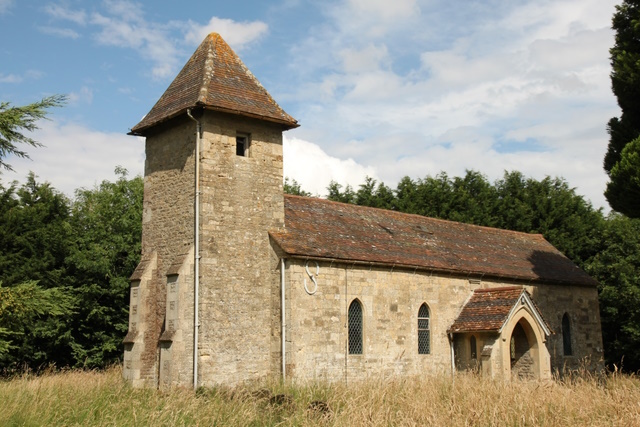


























Holy Trinity Church, Godington
Holy Trinity Church in Godington is a small Georgian building with seating for only 50 persons. It consists of a rectangular body without structural division between nave and chancel, and has a small western tower and a south porch. The original rectangular casement windows were converted into lancets in the 19th century. The only relic of the medieval church is the circular font. The old building was considered 'very indifferent' by Rawlinson; it had already been reported 'out of repair' in the late 17th century; in 1757 the chancel screen among other things needed rebuilding, and by 1790 the church was in danger of falling down. In 1792 a new one was built at the expense of William Fermor, the Roman Catholic lord of the manor, who employed a co-religionist as builder. In the 19th century the roof caused trouble and around 1850 the rector, T. T. Haverfield, planned to rebuild the church in a 12th-century style, but was unable to raise the money. He did, however, in 1852 install pointed windows in the chancel in place of the 'old shabby ones', a new pulpit, open seats, and an altar at a cost of about £100. The church was restored and the south porch added in 1905. When the church was rebuilt, some of the monumental inscriptions from the old church were transferred to it. These include stone slabs to James Benskyn, rector (d. 1643); to the family of Theodore Fletcher, rector (d. 1706); to Frances Busby, daughter of Charles Busby, gent. (d. 1679, aged 4); and an interesting inscription, formerly in the chancel but now on the floor of the tower, to George Sargeante of Brill (d. 1668), a surveyor 'known in most parts of England, Ireland and Wales'. Those to Ralph Coker (d. 1648), son of John Coker of Bicester, John Kerswell, rector (d. 1668), and Charles Howse (d. 1705), have not survived. At the Reformation the church possessed two sets of vestments, two copes, a silver-gilt chalice, and a brass cross. There was a light supported by lands worth 1s. 6d. a year. In 1955 the church owned a silver chalice and paten cover of 1674. The former was inscribed: 'enlarged for the use of the church of Godington by Mr. Mew, late Rector, 1674.' In the 16th century there were three bells and a sanctus bell. Rawlinson noted 'three new bells'. One of these, cast in 1717, was in use in 1955, and the other two were sold to help rebuild the church in 1792. The sanctus bell is of 1793. The register of baptisms and burials dates from 1672, that of marriages from 1679. There are many Roman Catholic gravestones in the churchyard. Historical information about Holy Trinity Church is provided by 'Parishes: Godington', in A History of the County of Oxford: Volume 6, ed. Mary D Lobel (London, 1959), pp. 146-152. British History Online http://www.british-history.ac.uk/vch/oxon/vol6/pp146-152 [accessed 31 January 2023].. Holy Trinity Church is a Grade II listed building. For more information about the listing see CHURCH OF HOLY TRINITY, Godington - 1046448 | Historic England. For more information about Holy Trinity Church see Parishes: Godington | British History Online (british-history.ac.uk). |

